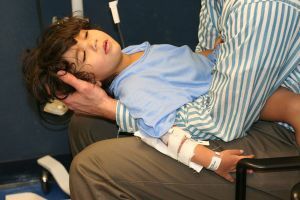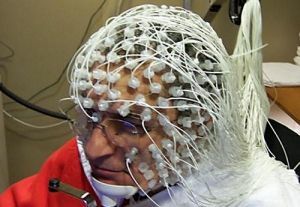 Idiopathic epilepsy is a disease characterized by impaired brain function and in the work of the nervous system. More common among young people( children and adolescents).
Idiopathic epilepsy is a disease characterized by impaired brain function and in the work of the nervous system. More common among young people( children and adolescents).
This is a serious disease that can lead to disruption of the nervous system and a significant deterioration in the patient's condition. Despite the fact that this disease is known for a long time, today there is not thought of an effective method of treatment that could completely rid of the ailment.
Idiopathic epilepsy develops in children aged 4-10 years and 12-18.And in children under 10 years, the disease develops much more often.
Contents
- Classification of the disease
- Prognostic factors
- Clinic of the disease
- Diagnosis
- Astigent seizure
- Lifestyle and warnings
- Complications and prevention
Classification of the disease
To date, the following forms of the disease can be distinguished:
- benign neonatal cramps;

- myoclonic epilepsy;
- absence of epilepsy;
- juvenile myoclonic epilepsy;
- absence of juvenile epilepsy;
- epilepsy with severe outbreaks of the disease;
- epilepsy with genitalized symptoms.
These are the most common forms of the disease, although other variants of this diagnosis are known to medicine. By localization, this type of disease is of two types: locally-conditioned( idiopathic focal epilepsy) and generalized.
Absence types of epilepsy are distinguished among the others by a short-term loss of consciousness of a sick person, suspension of his sight and not control of actions. The duration of one attack can be different, but on average it is from five seconds to three minutes.
Myoclonus, as a rule, is manifested by uncontrolled and repetitive movements of a person that occur unexpectedly. This type of epilepsy can cover the entire body, as well as individual muscle groups.

Provoking Factors of
To date, it has not been possible to identify all the causes of idiopathic epilepsy. One of the most common factors of the disease is a genetic predisposition.
So, for example, if the mother or father has such a disease, then in 10% of cases the child will have this diagnosis. To a rare reason for the development of the disease is the taking of certain medicines.
Other reasons for the development of the disease include the following:
- alcohol and drug addiction;
- psychoneurotic diseases;
- infectious diseases;
- oncology;
- pathology in the development of the brain;
- traumatic brain injury.
But scientists have succeeded in revealing that this disease begins to develop due to a violation of brain structure or gray matter. That is, provoking factors of the disease can also be called strokes and disruption of the nervous system.
Clinic of the disease
As a rule, the symptoms of this disease are pronounced, and therefore it is almost impossible to confuse it with the development of another disease. Signs of epilepsy of this type depend on the age of the patient, the degree of development of the disease and the individual qualities of a person.
Symptoms of idiopathic epilepsy include:
- loss of consciousness;

- partial seizures;
- loss of muscle tone;
- muscle weakening;
- jerking of limbs or whole body;
- vomiting;
- vision impairment;
- loss of orientation.
The duration of symptoms depends on the type of attack and the course of the disease.
The diagnosis of
 Early diagnosis is very important in the study of epilepsy. In addition, for a quick recovery of the patient, it must be accurate. The first thing you need to start with is to identify the reasons for the attack. Treatment will depend on the causes of the manifestation of the disease.
Early diagnosis is very important in the study of epilepsy. In addition, for a quick recovery of the patient, it must be accurate. The first thing you need to start with is to identify the reasons for the attack. Treatment will depend on the causes of the manifestation of the disease.
One of the important methods in diagnostics is electroencephalography, thanks to which it is possible to identify electrical potentials between two points. To carry out this procedure on the head, wear electrodes. This method allows to identify the focus of inflammation, the characteristics of waves and the change in the state of a sick person during the period between attacks.
In addition, the patient should be examined by a neurologist who, after examination, can draw such conclusions:
- how much the reflexes are expressed in the patient;
- are there any deviations in the emotional and intellectual spheres;
- is the patient's normal condition.
Auxiliary methods for confirming the diagnosis, you can name the following:
- MRI;
- CT;
- Echo-encephalogram;
- Brain vessel aneuriography.
Coping seizures
As mentioned above, it is impossible to completely get rid of the disease today, and therefore treatment has to be done all life.
But if you regularly treat, it will be possible for some time to avoid relapses and forget about seizures for several years. However, with any provoking factors, the disease will manifest itself with renewed vigor. 
There are cases when surgical intervention is required. But, as a rule, these manipulations are necessary only with partial epilepsy.
Often, in order to overcome the disease, it is necessary to take sodium valproate, which is most effective in fighting bouts. In 75% of cases after the completed treatment the patient's condition improved.
Clonazepam is an equally common drug that can prevent seizures. But this tool has side effects and is addictive.
The drugs that doctors prescribe for the treatment of idiopathic epilepsy include the following:
- Topiramate;
- Ethosuximide;
- Levetiracetam;
- Lamotrigine;
- Carbamazepine;
- Pyracetam;
- Valproate.
A person who suffers from idiopathic epilepsy must constantly take medication, otherwise complications can not be avoided. Also in the treatment can be used and methods of traditional medicine, if herbal preparations have no contraindications and side effects.
Lifestyle and Cautions
 In order to improve the patient's condition, it is necessary to adhere to the diet prescribed by the doctor. As a rule, it does not differ from diets prescribed for people with other forms of epilepsy.
In order to improve the patient's condition, it is necessary to adhere to the diet prescribed by the doctor. As a rule, it does not differ from diets prescribed for people with other forms of epilepsy.
Some doctors exclude liquid from the patient's diet, other doctors prescribe a protein-free or salt-free diet. Without fail the patient will have to refuse the following:
- alcohol;
- coffee;
- tea;
- smoking.
The doctor can prescribe a ketogenic diet, which is aimed at reducing seizures. It starts with starvation, that is, you can drink  only non-carbonated water. Beginning on the fourth day, it is allowed to enter certain foods. Food should be eaten with lots of fat.
only non-carbonated water. Beginning on the fourth day, it is allowed to enter certain foods. Food should be eaten with lots of fat.
As a rule, people who have this disease identified are considered disabled, because they have certain limitations in relation to work.
So, people with this diagnosis can not work with the following techniques and in such areas:
- with computing devices;
- on conveyor lines;
- with water, chemicals;
- with foci of inflammation and inflammation;
- in enterprises with low or high temperatures.
In order to prevent a sick person from harming their health, the following recommendations should be adhered to:
- to limit the use of piercing-cutting objects;
- drive the car only in the presence of others;
- rest every year in a sanatorium;
- visit swimming pools, ponds, rivers in the presence of others;
- every day to walk in the fresh air and exercise.
Complications and prevention of
Complications of idiopathic epilepsy include the following:
- coma;
- cardiac arrest;
- death;
- shortness of breath.
 In case of remission, a person can forget about seizures for one year, but it is worth remembering that any provoking factor will resume the disease again. The prognosis of the disease depends on the therapy used.
In case of remission, a person can forget about seizures for one year, but it is worth remembering that any provoking factor will resume the disease again. The prognosis of the disease depends on the therapy used.
It should be noted that the disease can not be prevented, since its causes have not been fully revealed to date. But people can be involved in the prevention of the disease with secondary epilepsy.
In this case, the following actions can be attributed to provoking factors of seizures:
- head trauma;
- excessive physical activity;
- bad habits.
Idiopathic epilepsy is one of the most common diseases that mankind has to face. At observance of all references of the doctor it is possible to improve a status of the patient and to forget about attacks at least for a year. But a complete cure for this disease has not been invented until now.



